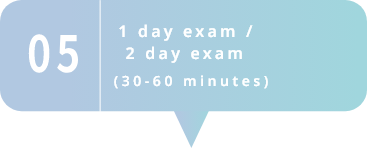
CATARACT SURGERY
If you are diagnosed with cataracts




A cataract is a condition in which the lens in the eye becomes cloudy, making it difficult for light to reach the retina and making it difficult to see. It can be said that 90% of cataracts are caused by "aging," and that almost all people are affected by aging. Cataracts are painless, but symptoms such as blurred vision, dark vision, blurred vision, loss of vision, double vision, and glare from light can occur. These symptoms can be almost completely cured with appropriate treatment.
Procedure of cataract surgery
Cataract surgery is a treatment to replace the lens with an "intraocular lens". The surgery takes only a few minutes to 30 minutes and is almost painless due to anesthesia.

Types of intraocular lens
There are monofocal IOLs that focus on only one place, such as in the distance, and multifocal IOLs that focus on multiple distances, such as in the distance and near.




Difference between monofocal and multifocal IOLs
| Monofocal | Multifocal | |
|---|---|---|
| Visibility | "far" or "near." Either one can be seen clearly |
Can see both "far" and "near“ |
| Glasses | Necessary | Glasses Necessary Glasses Necessary for some, but not for many cases. |
| Japanese health insurance | Cost of surgery Covered by Japanese health insurance (70-90%) | Not covered by Japanese health insurance |
Benefits and Risks of Multifocal Lenses

- It will be easier to live without glasses
- Focusing on multiple distances makes life easier without glasses. Suitable for people who cannot wear glasses for work or hobbies.

- You may feel halos and glare
- Halo glare may be experienced at night. It may not be suitable for those who drive a car at night, although it tends to lessen with time and is not bothersome.

- Contrast sensitivity will be reduced
- Contrast sensitivity is the ability to distinguish between shades of color. This may be a concern for some people, but they often become accustomed to it gradually.
Cataract Surgery Schedule
-
-

-
We will examine you to see if surgery is feasible.
An explanation of the intraocular lens will be given.
If you are a good candidate, a blood sample will be taken.
-
-
-

-
A full examination and consultation
Eye examinations necessary for the surgery, and a consultation (final confirmation) by the doctor will be conducted.
-
-
-

-
Antibacterial eye drops for 3 days
-
-
-

-
- Payment for the surgery
- The surgery(15-20minutes)
- Go home and take a good rest.
If needed, schedule surgery for another eye 2weeks later.
-
-
-

-
Examine for any abnormalities after surgery
We will check your eye conditions next day morning and the second day.
-
-
-

-
There will be periodic examinations at 1, 2, 3, 4, 6, and 8 weeks, and then every month thereafter.
-
Post-operative precautions
For a certain period of time after surgery, the following items of daily life may be restricted. Please check with your doctor or nurse for details and follow their instructions.
- Washing hair, face, and bathing
- Make up, eye make up
- Drinking alcohol
- Driving
- Sport
- light labour
Surgery Cost
|
Monofocal IOL |
Japanese health insurance coverageHigh-cost medical care system may apply. The co-payment limit varies depending on the co-payment ratio. |
Around ¥18,000 With JHI 90% coverage Around ¥50,000 With JHI 70% coverage Around ¥1650,000 Without Japanese Health Insurance |
|---|
|
Multifocal IOL |
Monofocal lens surgery cost
The cost of the lens will vary depending on the lens you choose, such as 2-focus/3-focus or astigmatism. Please select the appropriate lens for your life after receiving a full explanation and consultation from the doctor. |
Multi-focus IOL price ¥470,000(not for astigmatism include tax) ¥500,000(for astigmatism include tax) |
|---|
About payment
| Bank transfer | You are required to transfer the funds to the designated financial institution account. |
|---|---|
| Pay by cash | Pay by cash Payment in JPY(Japanese Yen) only |
※We do not accept credit card for the monofocal IOLs surgery covered by Japanese health insurance.

